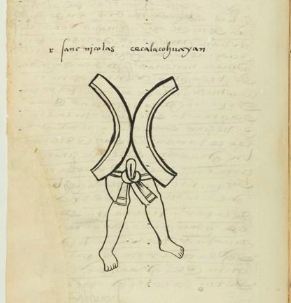Ce Calacohuayan (MH590v)
This black-line drawing of the compound glyph for the place name Ce Calacohuayan (“One Entrance,” attested here as a man’s name) shows the lower half of a man's body. He is wearing a loincloth. His feet are bare. In place of the upper half of his body are two curving objects. The interior curves touch one another. Each one also has a double line on the outer edge of the curve. The "one" is not specifically spelled out visually, but it may refer to the pair of curving objects. Similarly, the locative suffix (-yan) is not shown visually.
Stephanie Wood
It is unclear how the visuals connect to the gloss, which refers to one entrance. If the person is in motion, perhaps he is coming through an entrance, and perhaps the entrance involves structures that swing open. But this is all conjecture.
The two curving lines in this glyph do resemble the tlachtli from the Matricula de Huexotzinco on folio 501 verso. Perhaps the town of San Nicolas Ce Calacohuayan has a well know ball court? Another very similar glyph to this one adds bumps onto the curves which could be symbolic of the ball rings. See: Marc Thouvenot's TLACHIA, https://tlachia.iib.unam.mx/mh-cecalacohuayan/387_744r
Stephanie Wood
sanc nicolas cecalacohuayan
1560
Jeff Haskett-Wood
entradas, entryways, doors, puertas, taparrabos, loincloths, standing, a pie, curving, bending, curvar, doblar, nombres de lugares

calacohuayan, a door, an entry, https://nahuatl.wired-humanities.org/content/calacohuayan
ce, one, https://nahuatl.wired-humanities.org/content/ce
Una Entrada, o Pueblo de Una Entrada
Stephanie Wood
Matrícula de Huexotzinco, folio 590v, https://www.loc.gov/resource/gdcwdl.wdl_15282/?sp=260&st=image
This manuscript is hosted by the Library of Congress and the World Digital Library; used here with the Creative Commons, “Attribution-NonCommercial-ShareAlike 3.0 License” (CC-BY-NC-SAq 3.0).



